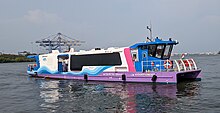|
Water transport in India
Water transport in India has played a significant role in the country's economy and is indispensable to foreign trade. India is endowed with an extensive network of waterways in the form of rivers, canals, backwaters, creeks and a long coastline accessible through the seas and oceans. It has the largest carrying capacity of any form of transport and is most suitable for carrying bulky goods over long distances. It is one of the cheapest modes of transport in India, as it takes advantage of natural track and does not require huge capital investment in construction and maintenance except in the case of canals. Its fuel efficiency contributes to lower operating costs and reduced environmental impact due to carbon. India has 14,500 kilometres or 9,000 miles of inland waterways, out of which 5,685 kilometres or 3,530 miles are navigable by mechanized vessels. Since 1947, India has made great progress in shipping and gradually became the second largest shipping country in Asia and sixth largest in the world. Indian ships ply on most of the shipping route of the world. India has a 6,100 kilometres (3,790 mi)-long coastline with only twelve major ports: Mumbai, Kandla, Jawaharlal Nehru Port (at Nehru Seve), Marmagaon, New Mangalore and Kochi on the west coast, alongside Kolkata, Chennai, Haldia, Paradeep, Vishakhapatnam and Tuticorin on the east coast. Jawaharlal Nehru Port of Mumbai has been developed as one of the major ports. It is the only fully mechanized port of India. The biggest port is Mumbai which handles largest number of ships as well as trade. Kandla port in Gujarat compensates the loss of the Port of Karachi to Pakistan. Vishakhapatnam is the third largest port of India. Kolkata is the largest inland port of Asia. Inland Waterways Authority of India has a vision to raise India's 111 national waterway's current cargo handling capacity from 55 MT in 2017–18 and 72 MT in 2018–19 to 100 MT by 2021–22.[1] Benefits of waterways transport    The cost of water transport in India is roughly 50 paise (0.58¢ US) a kilometre, as compared to ₹1 (1.2¢ US) by railways and ₹1.5 (1.7¢ US) by roads.[2] Water transport has received significant attention in recent times[timeframe?] as logistical costs in India are some of the highest among major countries[definition needed]—18 percent in India versus 8-10 percent in China and 10-12 percent in the European Union.[3] To increase the share of waterways in inland transport, the National Waterways Act, 2016 was passed which proposed 106 additional National Waterways.[4] This has the potential to greatly reduce the cost of transportation and lower the nation's carbon footprint by moving traffic from surface roads and railroads to waterways.[5] Prime Minister Narendra Modi launched the first Ro-Ro ferry service in Gujarat in October 2017.[6] Freight transport by waterways is highly under-utilized in India compared to other large countries and geographic areas such as the United States, China and the European Union. The total cargo moved (in tonne kilometres) by inland waterways was 0.1 percent of the total inland traffic in India, compared to the 21 percent figure for the United States. Inland Canals and Inland WaterwaysIndia has an extensive network of inland waterways in the form of rivers, canals, backwaters and creeks. The total navigable length is 14,500 km (9,000 mi), out of which about 5,200 km (3,200 mi) of river and 4,000 km (2,500 mi) of canal can be used by mechanized crafts. About 44 million tonnes (49,000,000 short tons) of cargo are moved annually through these waterways using mechanized vessels and country boats.[7]  Cargo transported in an organized manner is confined to a few waterways in Goa, West Bengal, Assam and Kerala. Inland waterways consist of the Ganges-Bhagirathi-Hooghly rivers, the Brahmaputra, the Barak river, the rivers in Goa, the backwaters in Kerala, inland waters in Mumbai and the deltaic regions of the Godavari-Krishna rivers.
NotesCoastal Waterways or Coastline Waterways Transport facilities available by ship along India's vast coastline are part of the coastal shipping system. Coastal shipping is one of the most important aspects of Indian Transport system. The country has a coastline of nearly 7,517 kilometres or 4,671 miles including the coastline of Andaman & Nicobar Islands and Lakshadweep Island. India has the largest merchant shipping fleet among developing countries and ranks 19th worldwide. Past decades saw a sharp decline in the country's coastal shipping operation. In 1961, there were 97 ships and in 1980 the number was down to 56.[8] The shipping policy committee has recommended that Indian ships secure 100% of the country's coastal trade. See also
References
External links |